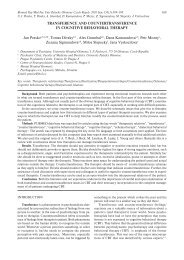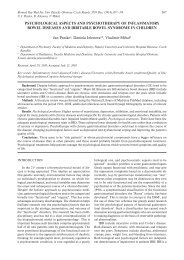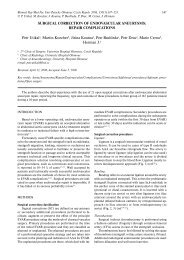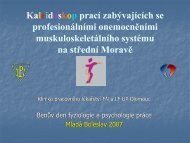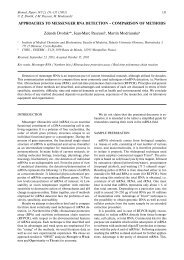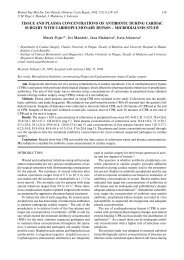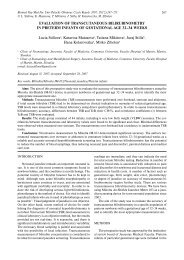Biomed Pap Med Fac Univ Palacky Olomouc Czech Repub. 2011 ...
Biomed Pap Med Fac Univ Palacky Olomouc Czech Repub. 2011 ...
Biomed Pap Med Fac Univ Palacky Olomouc Czech Repub. 2011 ...
Create successful ePaper yourself
Turn your PDF publications into a flip-book with our unique Google optimized e-Paper software.
<strong>Biomed</strong> <strong>Pap</strong> <strong>Med</strong> <strong>Fac</strong> <strong>Univ</strong> <strong>Palacky</strong> <strong>Olomouc</strong> <strong>Czech</strong> <strong>Repub</strong>. <strong>2011</strong> Mar; 155(1):3–10. DOI 10.5507/bp.155.<strong>2011</strong>.001© M. Kral, V. Rosinska, V. Student, M. Grepl, M. Hrabec, J. Bouchal3GENETIC DETERMINANTS OF PROSTATE CANCER: A REVIEWMilan Kral a *, Vlasta Rosinska a , Vladimir Student a , Michal Grepl a ,Martin Hrabec a , Jan Bouchal baDepartment of Urology, <strong>Univ</strong>ersity Hospital <strong>Olomouc</strong> and <strong>Fac</strong>ulty of <strong>Med</strong>icine and Dentistry, <strong>Palacky</strong> <strong>Univ</strong>ersity <strong>Olomouc</strong>,<strong>Czech</strong> <strong>Repub</strong>licbLaboratory of Molecular Pathology, <strong>Univ</strong>ersity Hospital <strong>Olomouc</strong> and <strong>Fac</strong>ulty of <strong>Med</strong>icine and Dentistry, <strong>Palacky</strong><strong>Univ</strong>ersity <strong>Olomouc</strong>E-mail: kral.milan@seznam.czReceived: September 9, 2010; Accepted: December 13, 2010Key words: Genetics/Prostate cancer/RiskBackground. In prostate cancer, early detection and appropriate treatment remain key approaches. But given theconstantly increasing incidence, prostate cancer ethiopathogenetic determinants are a current focus of attention.Although the development of this cancer is influenced by both environmental and genetic factors which are as yet illdefined,genetic studies have revealed gene abnormalities which may be specifically associated with the risk of prostatecancer: changes in genes for the androgen receptor, RNAseL, ELAC2, MSR1, BRCA 1 and 2, HPCX, KLF6, HPC20and fusion genes, e.g. TMPRSS2-ERG). Despite differing research results from molecular biological studies, thesetechniques can assist in earlier diagnosis enabling timely initiation of treatment.Methods. Methods and literature: MEDLINE search was performed to collect both original and review articlesaddressing prostate cancer and genetic risk factors using key words genetics, prostate cancer and risk.Conclusions. A number of potential genetic risk factors/markers has been identified which may in near futurecontribute to earlier diagnosis of prostate cancer so that earlier treatment can be started. Despite many promisingdata we have found differing results and therefore we suppose further research should be conducted to achieve moreprecise conclusion. This review focuses on current knowledge of the genetic factors affecting the development ofprostate cancer.INTRODUCTIONProstate cancer (PC) is now one of the most seriousoncological diseases in men with an incidence higherthan that of all other solid tumours. Currently, it is thesecond cause of cancer mortality worldwide 1 . However,while the incidence has been rising continuously sincethe 1980s when Prostate-Specific Antigen (PSA) testingwas introduced into clinical practice, the mortalityhas remained roughly the same. It was PSA testing thatled to an important shift towards the diagnosis of earlierprostate cancer stages (the so called stage migration) andthus better patient prognosis. Before the “PSA era“, themajority of prostate carcinomas were diagnosed on digitalrectal examination or histologically from prostatectomies(transurethral resection or suprapubic prostatectomy).Today we diagnose more than 70% of PCs from elevatedPSAs and the diagnosis is thus made up to 10 years earlierthan in the past. The screening not only refers to thetime factor. It also refers to the biological potential ofthe disease as we detect cancers with a lower malignancy(lower histopathological grading and lower cancer staging).On the other hand, a higher prevalence of aggressivecancers is affected by the recommendations for evaluationof prostate cancer grading (Gleason score) made at theUropathologists Conference ISUP in 2005 2,3 . Accordingto the National Cancer Institute (USA, programmeSurveillance, Epidemiology and End Results) 192.280new PC cases in the year 2009 with a current mortalityof 27.360 cases were estimated in the USA. From datafor the year 2005, in the <strong>Czech</strong> <strong>Repub</strong>lic we estimated100,2/100.000 and 28,39/100.000 cases for incidence andmortality, respectively (in absolute numbers the incidenceand prevalence in <strong>Czech</strong> <strong>Repub</strong>lic is 5094 and 1443 men,respectively) 4 .RISK FACTORS FOR PROSTATE CANCERWhile it is acknowledged that PC is a multifactorialdisease, no precise proven cause has been adduced.Although, an enviromental effect on the development ofPC is assumed, an important, possibly predominant roleis played by genetic predisposition. Differences betweenPC incidence and mortality in white and Afroamericanmen for example, testify to this (156 resp. 25 in white vs.248 resp. 59 in Afroamerican men /100 000 men) 1 .Enviromental factors include animal fat, alcohol, historyof vasectomy, smoking, obesity, statin and nonsteroidanti-inflammatory drug medication, vitamin D and E andmineral intake (calcium, selenium, zinc) and sexual activity.However, the conclusions of a large number of studieson these causative risk factors as either protective ordetrimental differ 5 . Androgens, oestrogens, insulin, IGF
4 M. Kral, V. Rosinska, V. Student, M. Grepl, M. Hrabec, J. Bouchal(insulin-like growth factor) and other hormones lie on theborderline of enviromental and genetic factors – levelscan vary according to individual genetic predispositionand external conditions (hormone substitution, obesity,comorbidities) 6,7 .GENETICS AND PROSTATE CANCERGenerally, oncological disease is caused by multiplegene mutations occurring during cell senescence (due tophysical, chemical or biological mutagens). These mutationshappen at several levels simultaneously. Suchchanges are common in healthy cells and do not necessarilylead into malignant transformation. Only if thereparation processes are unable to eliminate the existingmalignant cells, does unregulated growth and proliferationtake place where among other processes, apoptosisis suppressed. If such cell change or damage occurs in agerm cell, the changed information is transferred onto descendantsin a direct line. Typical for this kind of diseasetransfer in affected families is greater frequency of particulardiagnoses, disease onset is earlier, it is bilateral, multifocalor more aggressive than in the normal population(Table 1). Apart from mutation theory, current emphasisis on stem cell theory as explanatory of the pathogenesisof a number of diseases and not only cancer. For geneticallydetermined diseases we can reveal these changesusing the methods of molecular genetics (e.g. polymerasechain reaction, fluorescence in situ hybridisation, genomesequention etc.)Table 1. Examples of genetically determined cancers.Bilateral neurinoma of the acoustic nerveFamilial adenomatous polyposis of colonFamilial or bilateral breast or ovarian cancerHereditary clear cell and papillary renal carcinomaRetinoblastomaWilms’s tumourFamilial melanomaFamilial prostate cancerMultiple endocrine neoplasia (MEN I, II)Multiple cancer disease (breast, ovarianand non-small cell lung cancer)Prostate cancers can be divided for practical purposesinto three groups – hereditary, familial and sporadic.More than 85% of all prostate cancers are sporadic andonly 10–15 per cent cancers are genetically determined.We are able to establish genetic factors with varying degreesof probability. In analysis of population studies, ahigher incidence of PC was found in first line relatives 8,9(Table 2). The appearance of a high risk disposition allelefor PC is more frequent in men with cancers that werediagnosed at a younger age (43% of men younger than55, 34% of men younger than 70 and 9% of men youngerthan 85) 10,11 . Sporadic prostate cancers occur in men witha negative family history. Familial PC affects two or moremen in one family while true hereditary prostate cancersaffect three or more men in one family in three subsequentgenerations or two men aged 55 or younger.Table 2. Relation of family history and risk of prostatecancer (according to Bratt 9 ).Prostate cancerhistory in familyRelative riskAbsoluterisk (%)No 1 8Father or brother 2 15Father or brotheryounger than 60 years3 20Father and brother 4 30Hereditary prostatecancer5 35–45Meta-analyses of 33 epidemiological studies evaluatingfamilial risk of prostate cancer have shown that therelative risk of prostate cancer in a man with a brotheror father with PC is 3.4 and 2.2, respectively. This risk ishigher if there are more affected men in the first line thanin second line 12,13 .Not only a family history of prostate cancer but alsobreast/ ovarian cancer increase the risk for men in a givenfamilial line. In such case the relative risk is 1.7 and inthe case of incidence of PC together with breast or ovariancancer, the risk is 5.8 but results from other studiesdiffer 14–16 .Segregate studies have found a mostly autosomaldominant heredity in patients with sporadic and familialprostate cancer. Only in a small group of patients is heredityautosomal recessive or X-linked (gonosomal). We talkabout "prostate cancer susceptibility genes" (see below).In this model, 97% of patients with this genetic predispositionwill develop PC at the age of 85 compared with only10% of men without this genome. These genes are alsoinvolved in 65% of prostate cancers diagnosed before ageof 65 17,18 . Wide epidemiological studies on monozygoticand dizygotic twins have also yielded fruit. The most extensivestudy resulted from a database with nearly 16.000twins (World War II. veterans born in the USA between1917–1927). Prostate cancer was diagnosed in 1009 menand the incidence in monozygotic and dizygotic twinswas 27.1 and 7.1%, respectively 19 . These results were alsoconfirmed in Gronberg´s study of Swedish twins 20 .BIOLOGICAL BEHAVIOR OF FAMILIALAND HEREDITARY PROSTATE CANCERSStudies have compared the clinical and pathologicalfeatures of sporadic and hereditary prostate cancers inmen referred for PC treatment. Clinical and pathological
Genetic determinants of prostate cancer: A review5staging, serum PSA, postoperative progression of PSAand cancer specific mortality were evaluated. Kupelianet al presented the findings of 1038 men treated withradical prostatectomy or radiotherapy. The patients weredivided into two groups – those with positive and negativefamilial history. Survival without biochemical progressionafter 5 years in men with and without positive familial historywas 52% and 29%, respectively 21 , although the resultsfrom other centers are discordant. John Hopkins Hospitalgroup evaluated 94 men with familial prostate canceragainst 562 men with sporadic cancer treated by radicalprostatectomy. Over 65 months there was no difference inpathological features or progression interval 22 . Hanlon 23retrospectively evaluated 920 men after radiotherapywithout neoadjuvant hormonal treatment where 97 of themen fulfilled the criteria for familial or hereditary PC.Although the follow-up was relatively short, there wereno differences in terms of frequency or time to biochemicalfailure. Similar results were presented by Gronberg inSwedish men 24 , by Herkommer and Roupręt 25,26 .ANDROGEN RECEPTOR AND GENESOF STEROID HORMONE METABOLISMEpidemiological studies show that Scandinavian countrieshave constantly the highest incidence of PC. In contrast,PC incidence in Asian men living in Asia is thelowest in the world. However, the incidence rapidly riseswhen Asians move e.g. to the USA supporting the theoryof the relationship of PC and life-style. The PC prevalencein Afroamericans is significantly higher than in white menliving in the same area. Further, more Afroamericans thanCaucasian men have worse staging and PC grading as wellas a more aggressive disease course 27 . One explanationfor this is the different genetic equipment specially in theandrogen receptor (AR) gene. This gene is of great importanceand the focus of research interest because of itsphysiological and pathological functions in the prostaticcell. The AR gene is located on the short arm of chromosomeX (Xq11–12). This locus is one of the most conservativeregions of the human genome. Therefore onlya minimum of mutations occur in this region 28,29 . Thesize of the gene is 90 kbp and AR consists of 918 aminoacids. The AR comprises transactivation domain, DNAbinding domain and ligand binding domain. There is alsoan activation region responsible for ligand independentreceptor activation. After receptor activation it acts uponappropriate target regions on the DNA chain ( androgenresponsive elements) and as a result, the expressionof information coded in androgen-dependent genes (e.g.PSA, growth factors EGFR, VEGF, IGF, KGF, ARA andmany others) 30 .The variability in the AR gene length is determinedby polymorphism in the N-terminal region. The numberof CAG base triplet (polyglutamin) and GGC base triplet(polyglycin) repetition in the first exon of the ARgene is substantially lower in afroamerican men than incaucasians. The normal number of polyglutamin repetitionis 8–35 and most men have 21 repetition. With alower than 21 repetition, polyglutamin repetition might beconnected with higher prostate cancer risk, earlier onsetof disease and a more aggressive form, due to strongerbinding of ligand and its long-lasting hyperstimulation ofthe androgen receptor (afroamericans, white and asianmen have 18, 21 and 22 repeats, respectively). And conversely,a greater number of polyglutamin repeats (morethan 40) leads to alteration of the androgen receptor andits coactivator (with a lower fertility or Kennedy diseaseas a consequence). The number of glycin repeats can varyfrom 10–30 but the impact of abnormal repeat count onprostate cancer is still a matter of research in contrastto polyglutamin-chain length where we have much moreevidence for a relationship with prostate cancer development31–35 . In localised prostate cancers, androgen receptorgene mutations can be found only rarely (in around 1%)but are present in 30–45% of metastatic or hormonal resistantprostate cancers 36 .In accord with genetic predisposition for PC data, therole of the 5α-reductase type II gene (SRD5A2) is also amatter of debate. Its polymorphism plays an importantrole in androgen metabolism in prostate cells. It is presumedthat a larger number of dinucleotid repeats in thisenzyme increases its enzymatic activity with consequentlyincreased transformation of testosterone to dihydrotestosterone(DHT). On the other hand, data meta-analysis hasnot convincingly confirmed a higher risk of prostate cancerin this situation 37 . Cunningham et al analyzed geneticvariation in a total of 25 genes involved in androgen andestrogen metabolism and found that gene polymorphismsof AKR1C3, NQO1 and GSTT1 were weakly associatedwith familial PC 38 .GENES AND LOCI ASSOCIATEDWITH HEREDITARY PROSTATE CANCERAs mentioned above, 85% of PCs are sporadic andonly 15% are familial or hereditary. It was the much higherprevalence and earlier onset of this cancer in somefamilies that led to extensive genome studies to revealprostate cancer susceptibility genes or locuses similar tohigh risk genes in breast and ovarian cancer – BRCA1and BRCA2. The International Consortium of ProstateCancer Genetics was organized to provide systematic researchin this field. The aim was joint cooperation, sharingresearch data and preparation of metaanalyses 39 . Todate, a series of studies have identified putative genes veryprobably related to PC and, other genes are speculated(Table 3) 7,40–43 . Of all tested candidate genes for prostatecancer, the most important is gene RNAseL in locusHPC1, gene ELAC2 in locus HPC2, gene MSR1 on chromosome8, gene BRCA2, BRCA1 and others 44 . Althoughthe Human Genome project was completed more than10 years ago, there are more and more other locusesmapped and termed chronologically (HPC1-HPC20) aswell as gene mutations found with possible associationto PC development and progression (e.g. KLF6, PTEN,MAD1L1 and others) 45 .
6 M. Kral, V. Rosinska, V. Student, M. Grepl, M. Hrabec, J. BouchalLocalisation1q25.3Candidategene/locusRNaseL/HPC117p11 ELAC2 Unknown functionTable 3. Genes related to prostate cancer development.RemarkAge younger than 65 years, higher Gleason score, advanced cancer at timeof diagnosis; strongest relationship with PC in families with higher than 5affected menAffects induction of apoptosis and susceptibility to infection8p22–23 MSR1 Initiation of inflammation; affects induction and course of infectionXq27–28 HPCX Higher risk of PC in men with affected brother than with affected father20q13 HPC20 Higher age at PC diagnosis17q21 BRCA1 More frequent in younger men13q12–13 BRCA2 Function in DNA reparationHereditary Prostate Cancer 1This is probably the most important locus related toprostate cancer development. It is located on chromosome1q24–25 and a gene at position 1q25.3 is RNAseLencoding an endoribonuclease. This enzyme is importantin the immune response of the organism to viral infection(degradation of single-stranded RNA together with INFα), in apoptosis induction, cell cycle and cell differentiationregulation. Autosomal dominant hereditary is typicalfor RNAseL and this gene has high penetration. Thismeans that a carrier of this mutant variant has a high riskof prostate cancer development) 46 .Men with this predisposition are found to be of lowerage (
Genetic determinants of prostate cancer: A review7of hereditary prostate cancer. The presence of BRCA 1gene is more often related to men younger than 65 yearsbut in the case of the BRCA 2 gene, age does not playany important role although in younger men the mutationof BRCA 2 makes the risk even higher. BRCA 1 gene islocalised on 17q21 and plays a crucial role in keeping thegenome stable by controlling the cell cycle and by reparingimpaired DNA. The localisation of BRCA 2 gene is13q12–13 and it has similar function to BRCA 1.FUSION GENES AND OTHER ALTERATIONSIN SPORADIC CANCERSThe circumstances under which the genetic informationin prostate cells changes, do not automatically leadto prostate cancer. These changes occur frequently duringthe lifetime and it is repair mechanisms what can revealsuch mutation and further how relevant the mutation isand whether it can be repaired. In the contrary case, themutated cell can lead to clonal expansion with all possibleconsequencies. The problem is that these sporadic carcinomascount for up to 85% of all PCs although there isonly a minimal risk of cancer transfer to the next generationin the case of sporadic PC. Genetic changes can besimilar to those in hereditary cancers caused by not onlysingle-nucleotide mutation but by gene translocation. Theimportance of this form of mutation was demonstratedin the fusion of genes TMPRSS2 to ERG 61 . TMPRSS2is a serine protease whose significance has not been definedin detail. It is present in prostate cells and influencestheir physiological and pathological processes. Fusion ofTMPRSS2 to transcription factor ERG and others, e.g.ETV1, 4 ceteris paribus may increase the malignant potentialof cells and cause cancerogenesis. According toseveral studies, prostate cancers with this fusion are moreaggressive and have a worse prognosis although the resultsof other studies do not support this hypothesis 62,63 . Theloss-of-function mutation of KLF 6 (Krüppel-like factor 6at chromosome 10p15) is another genetic change whichcan lead to cell proliferation deregulation. Indeed, it hasbeen proven that KLF 6 mutation is present in up to 55%of sporadic prostate cancers although the original presumptionof importance in hereditary PCs has not beenconfirmed 31,64 . Among other factors we can list mutationsin genes c-Myc, E-cadherin, NKX31 and in tumour supressorgenes PTEN, p53 and RB 65 .CONCLUSIONDespite extensive research, prostate cancer from anethiopathological point of view remains a barely examineddisease. With further developments in the methods ofmolecular pathology we are offered new possibilities ofearly diagnosis, determination of disease prognosis andprediction of treatment results. Given its current global incidenceand sociological impact, prostate cancer remainsof central concern to urologists, pathologists, oncologistsand increasingly, molecular biologists and geneticists, albeitit may be some time before the results of the latterare applicable to clinical practice.REFERENCES1. Jemal A, Siegel R, Ward E, Hao Y, Xu J, Murray T, Thun MJ.Cancer statistics, 2008. CA Cancer J Clin 2008;58:71-96.2. Merrill RM, Stephenson RA. Trends in mortality rates in patientswith prostate cancer during the era of prostate specific antigenscreening. J Urol 2000;163:503-10.3. Epstein JI, Allsbrook WC Jr, Amin MB, Egevad LL. The 2005International Society of Urological Pathology (ISUP) ConsensusConference on Gleason Grading of Prostatic Carcinoma. Am JSurg Pathol 2005;29:1228-42.4. http://www.svod.cz/5. Strope SA, Andriole GL. Update on chemoprevention for prostatecancer. Curr Opin Urol 2010;20:194-7.6. Dvořáček J. Nádory prostaty. In: Dvořáček J, Babjuk M.:Onkourologie, 1. vydání, Galén; 2005;225-242.7. Klein EA, Platz EA, Thompson IM. Epidemiology, Etiology, andPrevention of Prostate Cancer. In: Wein AJ, Kavoussi LR, NovickAC, Partin AW, Peters CA. Campbell-Walsh Urology, Saunders,Philadelphia, 9th ed., 2007;2854-2867.8. Carter BS, Beaty TH, Steinberg GD, Childs B, Walsh PC.Mendelian inheritance of familial prostate cancer. Proc Natl AcadSci U S A 1992;89:3367-71.9. Bratt O. Hereditary prostate cancer: clinical aspects. J Urol2002;168:906-13.10. Carter BS, Bova GS, Beaty TH, Steinberg GD, Childs B, IsaacsWB, Walsh PC. Hereditary prostate cancer: epidemiologic andclinical features. J Urol 1993;150:797-802.11. Schaid DJ, McDonnell SK, Blute ML, Thibodeau SN. Evidencefor autosomal dominant inheritance of prostate cancer. Am J HumGenet 1998;62:1425-38.12. Zeegers MP, Jellema A, Ostrer H. Empiric risk of prostate carcinomafor relatives of patients with prostate carcinoma: a metaanalysis.Cancer 2003;97:1894-903.13. Bruner DW, Moore D, Parlanti A, Dorgan J, Engstrom P. Relativerisk of prostate cancer for men with affected relatives: systematicreview and meta-analysis. Int J Cancer 2003;107:797-803.14. Kalish LA, McDougal WS, McKinlay JB. Family history and therisk of prostate cancer. Urology 2000;56:803-6.15. Mastalski K, Coups EJ, Ruth K, Raysor S, Giri VN. Substantialfamily history of prostate cancer in black men recruited for prostatecancer screening: results from the Prostate Cancer RiskAssessment Program. Cancer 2008;113:2559-64.16. Chen YC, Page JH, Chen R, Giovannucci E. Family history ofprostate and breast cancer and the risk of prostate cancer in thePSA era. Prostate 2008;68:1582-91.17. Valeri A, Briollais L, Azzouzi R, Fournier G, Mangin P, Berthon P,Cussenot O, Demenais F. Segregation analysis of prostate cancer inFrance: evidence for autosomal dominant inheritance and residualbrother-brother dependence. Ann Hum Genet 2003;67:125-37.18. Verhage BA, Baffoe-Bonnie AB, Baglietto L, Smith DS, Bailey-Wilson JE, Beaty TH, Catalona WJ, Kiemeney LA. Autosomaldominant inheritance of prostate cancer: a confirmatory study.Urology 2001;57:97-101.19. Page WF, Braun MM, Partin AW, Caporaso N, Walsh P. Heredityand prostate cancer: a study of World War II veteran twins. Prostate1997;33:240-5.20. Gronberg H, Damber L, Damber JE. Studies of genetic factors inprostate cancer in a twin population. J Urol 1994;152:1484-7.21. Kupelian PA, Kupelian VA, Witte JS, Macklis R, Klein EA. Familyhistory of prostate cancer in patients with localized prostate cancer:an independent predictor of treatment outcome. J Clin Oncol1997;15:1478-80.22. Bova GS, Partin AW, Isaacs SD, Carter BS, Beaty TL, Isaacs WB,Walsh PC. Biological aggressiveness of hereditary prostate cancer:long-term evaluation following radical prostatectomy. J Urol1998;160:660-3.
8 M. Kral, V. Rosinska, V. Student, M. Grepl, M. Hrabec, J. Bouchal23. Gronberg H, Damber L, Tavelin B, Damber JE. No difference insurvival between sporadic, familial and hereditary prostate cancer.Br J Urol 1998;82:564-7.24. Hanlon AL, Hanks GE. Patterns of inheritance and outcome inpatients treated with external beam radiation for prostate cancer.Urology 1998;52:735-8.25. Herkommer K, Paiss T, Merz M, Gschwend JE, Kron M.Association of a positive family history with histopathologyand clinical course in early-onset prostate cancer. Urologe A2006;45:1532-9.26. Roupret M, Fromont G, Bitker MO, Gattegno B, Vallancien G,Cussenot O. Outcome after radical prostatectomy in young menwith or without a family history of prostate cancer. Urology2006;67:1028-32.27. Robbins AS, Yin D, Parikh-Patel A. Differences in prognostic factorsand survival among White men and Black men with prostatecancer, California, 1995-2004. Am J Epidemiol. 2007;166:71-8.28. Gottlieb B, Beitel LK, Wu JH, Trifiro M. The androgen receptorgene mutations database (ARDB): 2004 update. Hum Mutat2004;23:527-33.29. Brooke GN, Bevan CL. The role of androgen receptor mutationsin prostate cancer progression. Curr Genomics 2009;10:18-25.30. Lukeš M: Hereditární karcinom prostaty. In: Záleský M, Lukeš M:Molekulární genetika karcinomu prostaty. Galén, 2002;77-89.31. Narla G, Friedman SL, Martignetti JA. Kruppel cripples prostatecancer: KLF6 progress and prospects. Am J Pathol 2003;162:1047-52.32. Suzuki H, Ueda T, Ichikawa T, Ito H. Androgen receptor involvementin the progression of prostate cancer. Endocr Relat Cancer2003;10:209-16.33. Chen C, Lamharzi N, Weiss NS, Etzioni R, Dightman DA, BarnettM et al. Androgen receptor polymorphisms and the incidence ofprostate cancer. Cancer Epidemiol Biomarkers Prev 2002;11:1033-40.34. Silva Neto B, Koff WJ, Biolchi V et al. Polymorphic CAG andGGC repeat lengths in the androgen receptor gene and prostatecancer risk: analysis of a Brazilian population. Cancer Invest2008;26:74-80.35. Brinkmann AO. Molecular basis of androgen insensitivity. Mol CellEndocrinol 2001;179:105-9.36. Marcelli M, Ittmann M, Mariani S, Sutherland R, Nigam R, MurthyL, Zhao Y, DiConcini D, Puxeddu E, Esen A, Eastham J, WeigelNL, Lamb DJ. Androgen receptor mutations in prostate cancer.Cancer Res 2000;60:944-9.37. Ntais C, Polycarpou A, Ioannidis JP. SRD5A2 gene polymorphismsand the risk of prostate cancer: a meta-analysis. CancerEpidemiol Biomarkers Prev 2003;12:618-24.38. Cunningham JM, Hebbring SJ, McDonnell SK, Cicek MS,Christensen GB, Wang L, Jacobsen SJ, Cerhan JR, Blute ML,Schaid DJ, Thibodeau SN. Evaluation of genetic variations in theandrogen and estrogen metabolic pathways as risk factors for sporadicand familial prostate cancer. Cancer Epidemiol BiomarkersPrev 2007;16:969-78.39. Ostrander EA, Johannesson B. Prostate cancer susceptibility loci:finding the genes. Adv Exp <strong>Med</strong> Biol 2008;617:179-90.40. Stanford JL, McDonnell SK, Friedrichsen DM, Carlson EE,Kolb S, Deutsch K et al. Prostate cancer and genetic susceptibility:a genome scan incorporating disease aggressiveness. Prostate2006;66:317-25.41. Easton DF, Schaid DJ, Whittemore AS, Isaacs WJ. Where are theprostate cancer genes? A summary of eight genome wide searches.Prostate 2003;57:261-9.42. Schaid DJ. The complex genetic epidemiology of prostate cancer.Hum Mol Genet 2004;13 Spec No 1:R103-21.43. Hatcher D, Daniels G, Osman I, Lee P. Molecular mechanismsinvolving prostate cancer racial disparity. Am J Transl Res2009;1:235-48.44. Simard J, Dumont M, Labuda D, Sinnett D, Meloche C, El-Alfy M,Berger L, Lees E, Labrie F, Tavtigian SV. D et al. Prostate cancersusceptibility genes: lessons learned and challenges posed. EndocrRelat Cancer 2003;10:225-59.45. http://www.ncbi.nlm.nih.gov/entrez/ (OMIM – Online MendelianInheritance in Men)46. Klein EA: Genetická náchylnost a oxidační stres u karcinomu prostaty:integrovaný model s doporučeními pro prevenci. Urol List2006;4(4),19-24.47. Smith JR, Freije D, Carpten JD, Grönberg H, Xu J, Isaacs SD,Brownstein MJ, Bova GS, Guo H, Bujnovszky P, Nusskern DR,Damber JE, Bergh A, Emanuelsson M, Kallioniemi OP, Walker-Daniels J, Bailey-Wilson JE, Beaty TH, Meyers DA, Walsh PC,Collins FS, Trent JM, Isaacs WB. Major susceptibility locus forprostate cancer on chromosome 1 suggested by a genome-widesearch. Science 1996;274:1371-4.48. Grönberg H, Isaacs SD, Smith JR, Carpten JD, Bova GS, FreijeD, Xu J, Meyers DA, Collins FS, Trent JM, Walsh PC, IsaacsWB. Characteristics of prostate cancer in families potentiallylinked to the hereditary prostate cancer 1 (HPC1) locus. JAMA1997;278:1251-5.49. Li H, Tai BC. RNASEL gene polymorphisms and the risk of prostatecancer: a meta-analysis. Clin Cancer Res 2006;12:5713-9.50. Shook SJ, Beuten J, Torkko KC, Johnson-Pais TL, Troyer DA,Thompson IM, Leach RJ. KC et al. Association of RNASEL variantswith prostate cancer risk in Hispanic Caucasians and AfricanAmericans. Clin Cancer Res 2007;13:5959-64.51. Rennert H, Bercovich D, Hubert A, Abeliovich D, Rozovsky U,Bar-Shira A, Soloviov S, Schreiber L, Matzkin H, Rennert G,Kadouri L, Peretz T, Yaron Y, Orr-Urtreger A. A novel foundermutation in the RNASEL gene, 471delAAAG, is associated withprostate cancer in Ashkenazi Jews. Am J Hum Genet 2002;71:981-4.52. Orr-Urtreger A, Bar-Shira A, Bercovich D, Matarasso N, RozovskyU, Rosner S, Soloviov S, Rennert G, Kadouri L, Hubert A, RennertH, Matzkin H. RNASEL mutation screening and association studyin Ashkenazi and non-Ashkenazi prostate cancer patients. CancerEpidemiol Biomarkers Prev 2006;15:474-9.53. Schlaberg R, Choe DJ, Brown KR, Thaker HM, Singh IR. XMRVis present in malignant prostatic epithelium and is associated withprostate cancer, especially high-grade tumors. Proc Natl Acad SciUSA 2009;106:16351-6.54. Rebbeck TR, Walker AH, Zeigler-Johnson C, Weisburg S, MartinAM, Nathanson KL, Wein AJ, Malkowicz SB. Association ofHPC2/ELAC2 genotypes and prostate cancer. Am J Hum Genet2000;67:1014-9.55. Shea PR, Ferrell RE, Patrick AL, Kuller LH, Bunker CH. ELAC2and prostate cancer risk in Afro-Caribbeans of Tobago. Hum Genet2002;111:398-400.56. Kouprina N, Pavlicek A, Noskov VN, Solomon G, Otstot J, IsaacsW, Carpten JD, Trent JM, Schleutker J, Barrett JC, Jurka J,Larionov V. Dynamic structure of the SPANX gene cluster mappedto the prostate cancer susceptibility locus HPCX at Xq27. GenomeRes 2005;15:1477-86.57. Baffoe-Bonnie AB, Smith JR, Stephan DA, Schleutker J, CarptenJD, Kainu T, Gillanders EM, Matikainen M, Teslovich TM,Tammela T, Sood R, Balshem AM, Scarborough SD, Xu J, IsaacsWB, Trent JM, Kallioniemi OP, Bailey-Wilson JE. A major locusfor hereditary prostate cancer in Finland: localization by linkagedisequilibrium of a haplotype in the HPCX region. Hum Genet2005;117:307-16.58. Farnham JM, Camp NJ, Swensen J, Tavtigian SV, Albright LA.Confirmation of the HPCX prostate cancer predisposition locus inlarge Utah prostate cancer pedigrees. Hum Genet 2005;116:179-85.59. Berry R, Schroeder JJ, French AJ, McDonnell SK, Peterson BJ,Cunningham JM, Thibodeau SN, Schaid DJ. Evidence for a prostatecancer-susceptibility locus on chromosome 20. Am J HumGenet 2000;67:82-91.60. Sun J, Hsu FC, Turner AR, Zheng SL, Chang BL, Liu W, IsaacsWB, Xu J. Meta-analysis of association of rare mutations and commonsequence variants in the MSR1 gene and prostate cancer risk.Prostate 2006;66:728-37.61. Tomlins SA, Rhodes DR, Perner S, Dhanasekaran SM, Mehra R,Sun XW, Varambally S, Cao X, Tchinda J, Kuefer R, Lee C, MontieJE, Shah RB, Pienta KJ, Rubin MA, Chinnaiyan AM. Recurrent
Genetic determinants of prostate cancer: A review9fusion of TMPRSS2 and ETS transcription factor genes in prostatecancer. Science 2005;310:644-8.62. Jamaspishvili T, Kral M, Khomeriki I, Student V, Kolar Z, BouchalJ. Urine markers in monitoring for prostate cancer. Prostate CancerProstatic Dis 2010;13:12-9.63. Albadine R, Latour M, Toubaji A, Haffner M, Isaacs WB, A PlatzE, Meeker AK, Demarzo AM, Epstein JI, Netto GJ. TMPRSS2-ERG gene fusion status in minute (minimal) prostatic adenocarcinoma.Mod Pathol 2009;22:1415-22.64. Koivisto PA, Hyytinen ER, Matikainen M, Tammela TL, Ikonen T,Schleutker J. Kruppel-like factor 6 germ-line mutations are infrequentin Finnish hereditary prostate cancer. J Urol 2004;172:506-7.65. Dong JT. Prevalent mutations in prostate cancer. J Cell Biochem2006;97:433-47.




